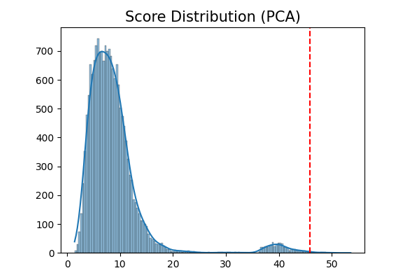piml.data.outlier_detection.IsolationForest¶
- class piml.data.outlier_detection.IsolationForest(n_estimators=100, max_samples='auto', max_features=1.0, bootstrap=False, n_jobs=None, random_state=None, verbose=0, warm_start=False, standardization=True)¶
A wrapper of sklearn’s Isolation Forest for outlier detection.
Return the anomaly score of each sample using the IsolationForest algorithm
The IsolationForest ‘isolates’ observations by randomly selecting a feature and then randomly selecting a split value between the maximum and minimum values of the selected feature.
Since recursive partitioning can be represented by a tree structure, the number of splittings required to isolate a sample is equivalent to the path length from the root node to the terminating node.
This path length, averaged over a forest of such random trees, is a measure of normality and our decision function.
Random partitioning produces noticeably shorter paths for anomalies. Hence, when a forest of random trees collectively produce shorter path lengths for particular samples, they are highly likely to be anomalies.
- Parameters:
- n_estimatorsint, default=100
The number of base estimators in the ensemble.
- max_samples“auto”, int or float, default=”auto”
- The number of samples to draw from X to train each base estimator.
If int, then draw
max_samplessamples.If float, then draw
max_samples * X.shape[0]samples.If “auto”, then
max_samples=min(256, n_samples).
If max_samples is larger than the number of samples provided, all samples will be used for all trees (no sampling).
- max_featuresint or float, default=1.0
The number of features to draw from X to train each base estimator.
If int, then draw
max_featuresfeatures.If float, then draw
max(1, int(max_features * n_features_in_))features.
Note: using a float number less than 1.0 or integer less than number of features will enable feature subsampling and leads to a longer runtime.
- bootstrapbool, default=False
If True, individual trees are fit on random subsets of the training data sampled with replacement. If False, sampling without replacement is performed.
- n_jobsint, default=None
The number of jobs to run in parallel for both
fitandpredict.Nonemeans 1 unless in ajoblib.parallel_backendcontext.-1means using all processors.- random_stateint, RandomState instance or None, default=None
Controls the pseudo-randomness of the selection of the feature and split values for each branching step and each tree in the forest.
Pass an int for reproducible results across multiple function calls.
- verboseint, default=0
Controls the verbosity of the tree building process.
- warm_startbool, default=False
When set to
True, reuse the solution of the previous call to fit and add more estimators to the ensemble, otherwise, just fit a whole new forest.- standardizationbool, default=True
Whether to standardize covariates before running the algorithm.
- Attributes:
- estimator_
~sklearn.tree.ExtraTreeRegressorinstance The child estimator template used to create the collection of fitted sub-estimators.
- base_estimator_ExtraTreeRegressor instance
The child estimator template used to create the collection of fitted sub-estimators.
- estimators_list of ExtraTreeRegressor instances
The collection of fitted sub-estimators.
- estimators_features_list of ndarray
The subset of drawn features for each base estimator.
- estimators_samples_list of ndarray
The subset of drawn samples (i.e., the in-bag samples) for each base estimator.
- max_samples_int
The actual number of samples.
- offset_float
Offset used to define the decision function from the raw scores. We have the relation:
decision_function = score_samples - offset_.offset_is defined as follows. When the contamination parameter is set to “auto”, the offset is equal to -0.5 as the scores of inliers are close to 0 and the scores of outliers are close to -1. When a contamination parameter different than “auto” is provided, the offset is defined in such a way we obtain the expected number of outliers (samples with decision function < 0) in training.- n_features_in_int
Number of features seen during
fit.- feature_names_in_ndarray of shape (
n_features_in_,) Names of features seen during
fit. Defined only whenXhas feature names that are all strings.
- estimator_
Methods
decision_function(X[, scale])Predict raw outliers score of X using the fitted detector.
fit(X[, y, sample_weight])Fit the model.
predict([X, scale, threshold])Predict raw outlier indicator.
- decision_function(X, scale=True)¶
- Predict raw outliers score of X using the fitted detector.
For consistency, outliers are assigned with larger anomaly scores.
- Parameters:
- Xnumpy array of shape (n_samples, n_features)
The training input samples. Sparse matrices are accepted only if they are supported by the base estimator.
- scalebool, default=True
If True, scale X before calculating the outlier score.
- Returns:
- outlier_scoresnumpy array of shape (n_samples,)
The anomaly score of the input samples.
- fit(X, y=None, sample_weight=None)¶
Fit the model.
- Parameters:
- Xnp.ndarray of shape (n_samples, n_features)
Data features.
- ynp.ndarray of shape (n_samples,), default=None
Data response.
- sample_weightnp.ndarray of shape (n_samples, ), default=None
Sample weight.
- predict(X=None, scale=True, threshold=0.9)¶
Predict raw outlier indicator.
Normal samples are classified as 1 and outliers are classified as -1.
- Parameters:
- Xnumpy array of shape (n_samples, n_features)
The training input samples. Sparse matrices are accepted only if they are supported by the base estimator.
- scalebool, default=True
If True, scale X before calculating the outlier score.
- thresholdfloat, default=0.9
The quantile threshold of outliers. For example, the samples with outlier scores greater than 90% quantile of the whole sample will be classified as outliers.
- Returns:
- outlier_indicatornumpy array of shape (n_samples,)
The binary array indicating whether each sample is outlier.

